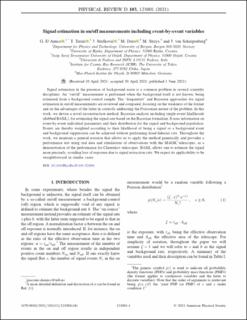| dc.contributor.author | D'Amico, Giacomo | |
| dc.contributor.author | Terzić, T. | |
| dc.contributor.author | Strišković, J. | |
| dc.contributor.author | Doro, M. | |
| dc.contributor.author | Strzys, M. | |
| dc.contributor.author | van Scherpenberg, J. | |
| dc.date.accessioned | 2021-12-01T10:42:35Z | |
| dc.date.available | 2021-12-01T10:42:35Z | |
| dc.date.created | 2021-09-21T16:39:40Z | |
| dc.date.issued | 2021 | |
| dc.identifier.issn | 2470-0010 | |
| dc.identifier.uri | https://hdl.handle.net/11250/2832317 | |
| dc.description.abstract | Signal estimation in the presence of background noise is a common problem in several scientific disciplines. An “on/off” measurement is performed when the background itself is not known, being estimated from a background control sample. The “frequentist” and Bayesian approaches for signal estimation in on/off measurements are reviewed and compared, focusing on the weakness of the former and on the advantages of the latter in correctly addressing the Poissonian nature of the problem. In this work, we devise a novel reconstruction method, Bayesian analysis including single-event likelihoods (dubbed BASiL), for estimating the signal rate based on the Bayesian formalism. It uses information on event-by-event individual parameters and their distribution for the signal and background population. Events are thereby weighted according to their likelihood of being a signal or a background event and background suppression can be achieved without performing fixed fiducial cuts. Throughout the work, we maintain a general notation that allows us to apply the method generically and provides a performance test using real data and simulations of observations with the MAGIC telescopes, as a demonstration of the performance for Cherenkov telescopes. BASiL allows one to estimate the signal more precisely, avoiding loss of exposure due to signal extraction cuts. We expect its applicability to be straightforward in similar cases. | en_US |
| dc.language.iso | eng | en_US |
| dc.publisher | American Physical Society | en_US |
| dc.title | Signal estimation in on/off measurements including event-by-event variables | en_US |
| dc.type | Journal article | en_US |
| dc.type | Peer reviewed | en_US |
| dc.description.version | publishedVersion | en_US |
| dc.rights.holder | Copyright 2021 American Physical Society | en_US |
| dc.source.articlenumber | 123001 | en_US |
| cristin.ispublished | true | |
| cristin.fulltext | original | |
| cristin.qualitycode | 1 | |
| dc.identifier.doi | 10.1103/PhysRevD.103.123001 | |
| dc.identifier.cristin | 1936747 | |
| dc.source.journal | Physical Review D | en_US |
| dc.relation.project | Norges forskningsråd: 301718 | en_US |
| dc.identifier.citation | Physical Review D. 2021, 103, 123001. | en_US |
| dc.source.volume | 103 | en_US |
